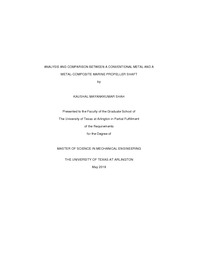
ATTENTION: The works hosted here are being migrated to a new repository that will consolidate resources, improve discoverability, and better show UTA's research impact on the global community. We will update authors as the migration progresses. Please see MavMatrix for more information.
Show simple item record
| dc.contributor.advisor | Beyle, Andrey | |
| dc.creator | Shah, Kaushal Mayankkumar | |
| dc.date.accessioned | 2018-06-05T18:42:58Z | |
| dc.date.available | 2018-06-05T18:42:58Z | |
| dc.date.created | 2018-05 | |
| dc.date.issued | 2018-05-16 | |
| dc.date.submitted | May 2018 | |
| dc.identifier.uri | | |
| dc.identifier.uri | http://hdl.handle.net/10106/27465 | |
| dc.description.abstract | The basic principal of a ship propulsion is the reactive (thrust) force generated by the propellers against the stream of water which forces the ship to propel in the opposite direction. The Shafting system is thus required to transmit the necessary torque to the propeller at a certain speed. Studies have suggested that shafts are the most common reason of failures among the whole marine propulsion system comprising of the main engine and propeller apart from the shaft. Stress concentration and torsional vibrations are the two major causes of failure in the propulsion shafting systems based on the case study of existing data. Other minor causes of shaft failures can be crack propagation in shaft line assembly, wear, corrosion, overload conditions, and material imperfections in the shaft. In comparison to Metals or Alloys, Composite materials have a high strength to weight ratio along with a high impact strength. Also, composites show a better fatigue resistance than most of the metals. By arranging the fibers in multiple directions using different orientations, the effect of stress and vibrations can be dampened. The overall aim of this paper is to analyze a Metal-Composite shaft for marine propulsion system which shows better behavior under various stress conditions as compared to the conventional metal/alloy shaft. A combination of metal and composite material in shafting system results in lower stresses and reduced torsional vibrations as compared to the existing metal shafts whereas the deformation over a longer period is also reduced. Moreover, the presence of composites in the shaft also provides superior thermal stability. The comparisons were done between the Conventional Metal shaft and the Metal-composite shaft under similar loading conditions using ANSYS Workbench for the simulation and results whereas the modelling was done using solid works 2017. | |
| dc.format.mimetype | application/pdf | |
| dc.language.iso | en_US | |
| dc.subject | Composite shaft | |
| dc.subject | Marine propulsion | |
| dc.title | ANALYSIS AND COMPARISON BETWEEN A CONVENTIONAL METAL AND A METAL-COMPOSITE MARINE PROPELLER SHAFT | |
| dc.type | Thesis | |
| dc.degree.department | Mechanical and Aerospace Engineering | |
| dc.degree.name | Master of Science in Mechanical Engineering | |
| dc.date.updated | 2018-06-05T18:45:05Z | |
| thesis.degree.department | Mechanical and Aerospace Engineering | |
| thesis.degree.grantor | The University of Texas at Arlington | |
| thesis.degree.level | Masters | |
| thesis.degree.name | Master of Science in Mechanical Engineering | |
| dc.type.material | text | |
| dc.creator.orcid | 0000-0001-9029-2294 | |
Files in this item
- Name:
- SHAH-THESIS-2018.pdf
- Size:
- 3.590Mb
- Format:
- PDF
This item appears in the following Collection(s)
Show simple item record


